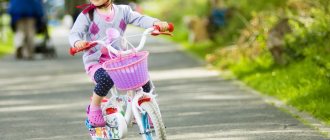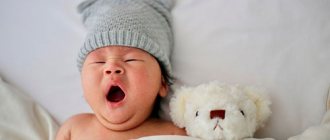Physical development of a one-year-old child
Statistics show that, on average, one-year-old children weigh 10-11 kg, and their height is approximately 72-77 cm. In this case, weight gain should be about 350 g per month, and height - 1.5 cm per month. After a year, the pace of the child’s physical development will gradually slow down.
Many mothers unwittingly compare their child's development with the development of other children, which causes many reasons for concern. “What if there’s something wrong with him?”, “I probably don’t do enough with the child,” and so on. It is worth noting that the pace of physical development up to one year is individual for each child. In this regard, only a really strong lag from the average statistical norm should be a reason for concern.
As a rule, by the age of 1 year, a child can sit, stand (with support), actively crawl and begin to take his first steps. One-year-old babies love to walk along the support and by the hand, and some even try to run. Also, with the help of an adult, the baby can slowly go up and down the stairs, climb on and off the sofa. Thanks to the ability to maintain an upright position, the baby's ability to explore the world expands. This is a very important step in the development of the baby. To help your child learn to walk confidently, do not force your help on him. Let the baby learn to walk short distances on his own, for example, to you or to a toy. Belay him at arm's length.
Since children of this age love to conquer all kinds of peaks, it is necessary to provide the child with proper safety. Do not leave your child unattended in a room with open windows, shelves that could be knocked over, electrical outlets, wires, or other dangerous objects.
First year of life: child development calendar
We present to your attention a detailed calendar of child development from birth until he reaches 12 months of age. The period up to one year is that stage of life when the baby learns everything around him, studies himself and those around him, therefore this is one of the most important life stages. Therefore, we read carefully.
First month
The first month of life is considered a period of adaptation for both mother and newborn baby. The baby's body gradually gets used to the new environment. If the child is healthy and nothing bothers him, he can spend most of the day sleeping. During short periods of wakefulness, the baby chaotically moves its arms and tucks its legs in its knees. From the first days of his life, he begins to listen to the conversations of others, the sounds of rattles and a musical mobile.
- Physical development
A newborn baby spends 70% of its time sleeping. In the first weeks of life, the baby often makes convulsive movements with its arms. Physical activity is based primarily on reflexes: sucking (reflexive sucking); grasping (putting a finger in the child’s palm, he tightly squeezes his fingers); search (the reflex allows you to find the breast nipple during feeding).
At this age, intestinal colic may begin to bother you. A warm diaper placed on the tummy before feeding, a light massage of the abdomen in a clockwise direction, placing it on the tummy and special herbal teas (dill water, fennel) will help get rid of them.
- Psychomotor development
Towards the end of 1 month, the baby brings his hands to his face (eyes, mouth) so that they are in sight. Lying on his stomach, during this period the child tries to turn his head from side to side, but still does not support its weight.
Key points in the development of a child in the first month of life:
- feedings on demand (can be up to 10-12 times a day, including at night);
- the child’s physical activity is based on reflexes (sucking, grasping, searching);
- crying is caused by discomfort;
- recognizes the mother's voice and smell, reacts to it;
- can focus his gaze on an adult's face or a stationary object for a few seconds.
Weight gain (on average) by the end of the month - 600 g. Increase in height - by 2-3 cm.
Second month
In the 2nd month of life, the child gradually develops a routine for eating and going to bed. By this age, the baby is already making his parents happy with his smile. A two-month-old baby is able to feel the emotional state of its mother. While awake, the baby moves its legs and arms more actively, especially when communicating with an adult.
- Physical development
In the second month of life, the baby holds his head more confidently. Lying on his stomach, the baby can hold his head for 10-15 seconds and turn it in different directions. A two-month-old baby's movements are more coordinated.
- Psychomotor development
What can a 2 month old baby do? He loves to look at faces, focuses his eyes for a long time on objects located at a distance of 20-30 cm. The sounds of humming “a-a-a”, “e-e-e”, etc. appear. He responds to a familiar voice with a smile and smiles when communicating with an adult.
Key points in the development of a child in the second month of life:
- reacts to sounds, turns his head towards its source;
- examines his own palms and fingers, squeezes them into fists and examines them;
- makes the first awkward attempts to reach the rattle;
- the newborn’s reflexes gradually fade away;
- The child’s visual apparatus improves; from this age the baby begins to show interest in bright objects.
Weight gain (on average) by the end of the month – 800 g. Increase in height – 3 cm.
Third month
At 3 months, the child changes every day, turning from a baby completely dependent on his mother into an active, sociable baby. By three months, the baby gets rid of newborn reflexes and learns to consciously control his body. The child becomes more and more interested in what is happening around him; new faces and voices arouse his curiosity. The baby may quietly “coo” and coo in response to communication.
- Physical development
A three-month-old baby rests confidently on his forearms while lying on his stomach. Controls fingers, opens and closes them. Holds your head well in an upright position.
- Psychomotor development
At this age, the baby can already grab and hold toys. The humming contains the drawn-out sounds “b-u”, “sh-i”, etc. When addressed by an adult, he actively moves his arms and legs, makes sounds, and rejoices.
Key points in the development of a child in the third month of life:
- knows how to turn from back to side in both directions;
- easily recognizes the source of sound and light and turns towards it;
- tries to grab and hold the rattle;
- pulls objects and his fingers into his mouth;
- examines his face with his hands, lifts and pulls his legs towards him.
Weight gain (on average) by the end of the month – 800 g. Increase in height – 2.5 cm.
Scheme of physical development of children from birth to 12 months:
Fourth month
At 4 months, the baby’s neck muscles are already sufficiently strengthened. The baby has mastered the ability to hold his head up and enjoys looking around at what is happening around him of his own free will. The child’s field of vision expands; now he sees not only the overall picture, but can also notice individual features. The grip of the baby's palms has become stronger, and the baby can now not only hold the rattle, but also try to move it from one handle to another.
- Physical development
A four-month-old baby can already easily roll over from side to back. Lying on his stomach, he raises his head and chin high. The movements of his hands and eyes are coordinated. Tries to grab a suspended toy, reaches for it.
- Psychomotor development
At four months, the baby recognizes familiar objects and faces from a distance. He smiles in response to his parents' speech. A four-month-old baby begins to imitate some sounds. It hums for a long time and in a singsong voice. Distinguishes mother from other adults. When strangers try to play with him, he becomes wary, but then becomes animated.
Key points in the development of a child in the fourth month of life:
- while lying on his back, makes the first attempts to sit up, raising his upper body;
- lying on his stomach makes the first crawling movements;
- when feeding from a bottle, supports it with his hands;
- follows moving objects with his eyes, fixes his gaze;
- curiously examines his reflection in the mirror in the arms of an adult.
Weight gain (on average) by the end of the month – 750 g. Increase in height – by 2-3 cm.
Fifth month
At 5 months, the baby can clearly see distant objects. He may smile at his mother standing in the middle of the room, and notice you a few meters away from the crib. A five-month-old baby peers with interest at the working TV screen. The child has already learned to roll over on his own and is trying to crawl on his stomach.
- Physical development
Five-month-old babies experience a new leap in development. Lying on his stomach, the baby rests on the surface with the palms of his outstretched arms. Supported by his armpits, he stands firmly on his legs. The baby is able to take a toy from the hands of an adult and hold it.
- Psychomotor development
At 5 months, the baby hums melodiously with varied intonation and volume. Captures the difference between affectionate and strict tones. When communication is interrupted, if the mother leaves, he kicks his legs and screams indignantly.
Key points in the development of a child in the fifth month of life:
- being raised to a vertical position and touching the surface with his feet, he tries to push off with his legs;
- hums and imitates sounds made by adults (“ma-ma”, “a-gu”);
- reaches for toys, grabs them and pulls them to his mouth;
- enjoys playing with an adult, but may cry if the game stops;
- At 5 months, many children begin to erupt their first teeth.
Weight gain (on average) by the end of the month – 700 g. Increase in height – 2 cm.
Sixth month
A child at 6 months better expresses his emotions and desires and often voices them. Now he can cry not only when he is uncomfortable or wants to eat. Crying may be caused by a desire to change activities or play with a different toy. Active strengthening of the back and neck muscles contributes to the ability to sit; the child can sit without support for a short time. But he will learn to squat on his own a little later. Lying on his stomach, he pulls up his legs one by one and tries to get on all fours in order to crawl.
- Physical development
At this age, when pulled up by the arms, the baby sits up from a position lying on his back. Sits with adult support or support in the form of pillows. Masters crawling forward. The child is already able to hold a toy and transfer it from one hand to another.
- Psychomotor development
A six-month-old baby can already distinguish his name from others and reacts to its pronunciation. The baby begins to babble, with individual syllables (“pa”, “ba”, “ma”). During this period, the baby loves to be in his mother's arms. The baby stops crying when he is picked up.
Key points in the development of a child in the sixth month of life:
- masters crawling “on his belly”, by the end of the 6th month he can crawl 20-30 cm towards an object;
- getting on all fours, he learns to sway back and forth, which helps strengthen the skill of crawling;
- uses both hands in play, transfers toys from one hand to the other;
- plays on an educational mat with an unbreakable mirror, prefers musical toys;
Weight gain (on average) by the end of the month – 650 g. Increase in height – 2 cm.
Seventh month
At 7 months, the baby experiences a real leap in emotional development. His character and temperament begin to emerge. He not only absorbs information, but also applies the acquired knowledge to everyday life. The child distinguishes large objects (watch, TV, mirror) and is able to show them. By the end of the month, the child will be able to briefly support his own weight on his feet and stand up independently, holding onto support with both hands.
- Physical development
A seven-month-old baby sits without support, supported on the palms of his hands. Enjoys throwing toys on the floor or knocking them against each other. Easily turns from stomach to back. Babies at this age are real fidgets.
- Psychomotor development
The baby babbles for a long time while in the crib. Distinguishes between close and unfamiliar people. Reacts to strangers by crying loudly. He can study his mother's face for a long time using his hands. Likes to look at pictures and leaf through books.
Key points in the development of a child in the seventh month of life:
- reaches for an object or towards mother with both hands;
- sits down with the help of an adult and sits without support;
- tries to attract attention, shows interest in simple games (“peek-a-boo”, “okay”);
- actively sings sounds, a simple onomatopoeia of animal voices appears (“ha-ha”, “quack-quack”);
- loves to leaf through books and look at bright pictures.
Weight gain (on average) by the end of the month – 600 g. Increase in height – 2 cm.
Eighth month
The child is much more active than in previous months. He can sit up and move around by crawling and stands up in his crib. The baby easily distinguishes his parents from strangers and will be able to find their faces even in photographs. Shows a desire to hold a spoon independently when eating. Understands simple requests - to show something or bring one of his toys.
- Physical development
An eight-month-old child enjoys walking and masters step-steps near any available support. Sits independently, and while crawling can stand up and swing on all fours.
- Psychomotor development
Babbles, repeating the syllables “ma-ma-ma”, “ba-pa”, etc. Masters the goodbye hand movement. Loves to play “peek-a-boo” and “okay”. When asking a question, he tries to look for a familiar object or person.
Key points in the development of a child in the eighth month of life:
- holding onto support, walks with side steps;
- easily navigates and moves from one place to another;
- the child no longer likes to lie down, he tries to take a vertical position at any opportunity;
- actively babbles, the vocabulary will be replenished with new sounds and simple words.
Weight gain (on average) by the end of the month – 550 g. Increase in height – 1.5 cm.
Ninth month
At 9 months, the baby feels confident standing on his feet and tries to take his first hesitant steps, holding on to support. He has not yet learned to get down on the floor without falling, so he may fall often. By the end of the month, the child will learn to better maintain balance and balance. The baby is already drinking well from a sippy cup with a spout and is learning to drink from an adult mug.
- Physical development
The baby is actively starting to learn to walk independently. A nine-month-old baby sits down and stands on its legs, holding onto a support, without the help of an adult. Walks with support from both hands.
- Psychomotor development
He begins to imitate himself, repeating random sounds and syllables. Reacts to his own name. He plays “okay” and waves “bye-bye.”
Key points in the development of a child in the ninth month of life:
- sits up from a lying position on his back/stomach independently;
- while crawling, it can turn around and move in any direction, not just forward;
- remembers the names of surrounding objects well and, upon request, shows them;
- reacts to the word “impossible”, understands prohibitions;
- babbles a lot in his own language, understandable only to those close to him.
Weight gain (on average) by the end of the month – 500 g. Increase in height – 1.5 cm.
Tenth month
The baby can maintain balance and even take several steps in a row until an adult picks him up. At 10 months, a child can play continuously for 15-20 minutes, get carried away with a pyramid or cubes. Can turn pages in books. Strives to play with other children at a party or on a walk.
- Physical development
A ten-month-old baby, holding onto a support with only one hand, can take independent steps. Squats and stands up at will for any object. The main method of movement is no longer crawling, but walking.
- Psychomotor development
Strives to copy adult speech, listens attentively to the conversation. Recognizes and finds familiar objects at the request of an adult (“give me Lala”, “where is the ball?”)
Key points in the development of a child in the tenth month of life:
- can stand for several moments without support;
- takes 2-3 steps forward without support;
- crawls on hands and knees, supporting body weight on them;
- loves to throw toys out of the crib/playpen;
- shows body parts on himself and on an adult.
Weight gain (on average) by the end of the month – 450 g. Increase in height – 1.5 cm.
Eleventh month
Babies at 11 months show curiosity about everything that surrounds them. The child strives to explore an object in a variety of ways - shaking it in the air, throwing it or hitting it on a surface. He loves to play the game “hidden toy” and finds it easily. In books, he looks at the correct picture when he hears the name of a certain object.
- Physical development
At 11 months, the child stands confidently without support. Actively learns to take the first step without support. Loves to move, dance to music, play with other children.
- Psychomotor development
Pronounces conscious babbling words (“ma-ma”, “pa-pa”, “av-av”). Reacts to the word “no”. Plays with a pyramid. Knows and shows parts of his body.
Key points in the development of a child in the eleventh month of life:
- actively moves (sits, lies down, stands up independently);
- partial to praise, also understands strict speech;
- can point with a finger at the desired object;
- new steps in communicating with an adult: waving “hello”/”bye” with a pen, nodding affirmatively or negatively waving his head;
- can independently pick up small pieces of food with his fingers.
Weight gain (on average) by the end of the month – 400 g. Increase in height – 1.5 cm.
Twelfth month (1 year)
By the age of one year, the child has already grown stronger as a small person. Here is a detailed description of what a one-year-old child can do. In short, he worries less in the presence of strangers, behaves assertively, and actively expresses his desires. Begins to demonstrate possessive tendencies towards mother or toys. The child’s vocabulary grows very quickly, the baby understands all speech addressed to him and tries to respond.
- Physical development
A one-year-old child stands confidently and walks without support. The baby is active in combing his hair, bathing, and dressing. Tries to hold a spoon independently and eat thick food from it; learns to drink from a mug.
- Psychomotor development
Pronounces the first words, correlating them with actions - “give”, “bang”, “am-am”. Fulfills simple requests - “go to mom,” “give me a cube.” Knows the purpose of simple objects (telephone, comb, toothbrush).
Key points in the development of a child in the twelfth month of life:
- can walk a short distance without support or support;
- bends over and picks up objects on the floor;
- can step over an obstacle in the form of a threshold or a lying toy;
- looks for the necessary item at will, even if he did not see where it was put;
- expresses his needs and desires in simple words. Calling mom and dad. Vocabulary by this age is 8-12 words.
Weight gain (on average) by the end of the month – 600 g. Increase in height – by 2-3 cm.
A useful story about how to care for a baby
Psychomotor development at 1 year
The baby’s mental development also does not stand still. Children at 1 year old can:
- Open and close doors, cabinets;
- Pull out drawers;
- Scoop up water;
- Collect pyramids of 2-3 rings;
- Build towers from 2 cubes;
- Putting things in a box;
- Play with sorters;
- Throw the ball;
- Roll the ball on the floor;
- Copy the actions of an adult: combing, cooking porridge, etc.
At 1 year old, children mainly learn about the world through feeling (tactile method). Also, the child can still put things in his mouth, tasting things. Children learn a lot by imitating adults. The baby can copy mom, who is preparing dinner, and try to imitate dad, who is repairing the car. Therefore, it is very important to remember that although the child does not always listen to you, he will always repeat after you and adopt your behavior model.
Differences in the development of boys and girls
Pediatricians have long noticed that there are differences in the development of newborn babies of different sexes. And although each child is individual, some patterns exist. For example:
– Boys are born larger than girls in height and weight. Thus, in full-term male newborns, the average height at birth is 53-56 cm, while in girls it is only 49-52 cm;
– speaking about children’s standards for general physical and mental growth, it is noted that the development of boys is slightly behind their peers already at the time of birth. But this difference is unnoticeable and lasts no more than 2-3 weeks;
– representatives of the fair sex are smaller at birth, but later the physical development of girls accelerates. On average, their bone skeleton is formed earlier than that of boys.
Social-communicative and speech development of a one-year-old child
The repertoire of expressed emotions in one-year-old children is already quite rich. A child can express his need by crying, being scared, or laughing. Body language and facial expressions are improved. The baby often shows feelings for you through hugs and kisses.
A big leap occurs in the development of a child’s speech. By the age of one year, babies usually already know how to pronounce syllables and simple words (mom, dad, baba, bibi, etc.). A child at this age can well grasp the intonation with which he is addressed and fulfills simple requests from an adult. There are no clear age limits for when exactly a child should speak. If you doubt that your baby’s speech development is within normal limits, seek help from a specialist to rule out problems such as hearing impairment, problems with the speech apparatus, neurological diseases, etc.
If your baby still doesn’t speak at one year old, but still understands you, don’t rush to sound the alarm. Talk to your child more and develop his fine motor skills.
Table with height and weight standards for children under one year old
Using a centile table, you can track the approximate norms of a child’s monthly weight gain, and how the baby’s body length should increase. Height and weight standards for children are given in terms of minimum/maximum values, so they can be used as a guide.
| Boys | Girls | ||||
| Age | Height (cm) | Weight, kg) | Age | Height (cm) | Weight, kg) |
| 1-2 months | 52-60 | 3,5-5,8 | 1-2 months | 51-59 | 3,1-5,2 |
| 3-4 months | 59-66 | 5,1-7,4 | 3-4 months | 57-64 | 4,6-7,1 |
| 5-7 months | 61-71 | 6,2-9,7 | 5-7 months | 61-69 | 6,1-8,7 |
| 8-10 months | 68-75 | 8-11 | 8-10 months | 66-73 | 7,3-10 |
| 10-12 months | 71-78 | 8,8-12 | 10-12 months | 69-76 | 7,6-11 |
Daily and nutritional regimen for 1 year old children
Many mothers of one-year-old children face the problem of changing their routine. Often a baby at this age has difficulty falling asleep during the day, so naps are postponed until later. With the transition to one nap during the day, you need to adjust the child’s diet. Typically, meals are eaten 4 times: for example, at 9 am - breakfast, at 1 pm - lunch, at 17 pm - afternoon snack and at 21 pm - dinner. At the same time, going to bed turns out to be quite late: at 22 - 23 pm.
The diet of a one-year-old child should exclude allergenic foods: chocolate, smoked meats, spices. Some doctors advise continuing to give the baby formula, but not in a bottle, but on a plate. Gradually transition your child to adult foods. To help your baby develop a chewing reflex, replace the puree with small pieces of not very hard food. It can be cutlets, fruits, bread.
Table of key moments in child development from 0 to 1 year
A brief overview of the table, which shows the development of a child up to one year old by month, will be an excellent “cheat sheet” for young mothers.
| Age | Speech development | Motor development | Mental development |
| 1-1.5 months | Quiet humming | First attempts to raise the head | Briefly follows the rattle with his eyes |
| 2 months | In a good mood, he hums a little | Coordinates movements better | Maintains gaze on a moving object |
| 3 months | Long hum | Holds his head confidently | Turns towards sound sources |
| 4 months | The first babble replaces the chatter | Doesn't take his eyes off moving objects | Distinguishes mom from strangers |
| 5 months | Babbles, pronounces the syllables “ma, pa” | Rolls over independently, crawls backwards | Wary of other people's voices |
| 6 months | Active babble, reproduces simple syllables | Crawls “on its bellies” | Shows emotions of joy and dissatisfaction |
| 7 months | Babbling, the appearance of the syllables “ta”, “na”, “da”, etc. | Sits with support, crawls forward | Understands intonation and the word “no” |
| 8 months | First monosyllable words | Stands up and moves around with support, sits independently | The range of emotions expands (surprise, persistence) |
| 9 months | Active babbling, new syllables | Stands and walks with support, crawls | Understands simple instructions |
| 10 months | Pronounces simple words “la-la”, “av-av” | Sits from a standing position, tries to walk | Repeats the facial expressions of adults |
| 11 months | Expresses desires – “na,” “give” | Picks up objects from the floor, stands up, squats | Shows familiar objects and body parts upon request |
| 12 months | Babbles a lot, consciously pronounces the words “mother”, “baba” | Actively moves, lies down, stands up, walks | Understands adult speech, responds to requests and prohibitions |
A short video summary of a child’s development by month:
Health of a one-year-old child
A visit to the pediatrician every year is considered a mandatory procedure. The doctor takes the necessary tests from the child and makes physiological measurements. The issue of child vaccination is also being addressed. It is also necessary to visit the following specialists: neurologist, surgeon, orthopedist. Additionally, it is advisable to consult an ophthalmologist and dentist.
An important component of a healthy lifestyle is maintaining the child’s personal hygiene. At one year of age, a baby can learn to wash his hands before eating and after a walk, as well as wash himself. If a child has grown at least 1 tooth, it is worth making friends with a toothbrush. And, of course, do not ignore evening bathing and rinsing in the shower.
Website "Child Development" for parents and children
The Child Development website is a source of useful information. The tips and tasks posted on the site are intended for the best parents in the world, as they help them raise happy children by choosing the right path for their development. Love, care and joy are feelings that are necessary for every child. Parents' care for their child and useful information for them are the key to the formation of an intelligent, comprehensively developed, contented child. “Child Development” is the best site for parents and children!
How to develop a child at 1 year old
To help your baby develop quickly and acquire more and more new skills, help him with this:
- Carry the child in your arms less, give him freedom of movement.
- Voice everything you see to your child and talk to him. Read books to your baby - this is so important for the development of a child’s speech.
- Play educational games: sorters, cubes, pyramids, lacing, etc. You can offer your child a simple role-playing game (for example, construction, racing, etc.). Finger games are good.
The development of a 1 year old baby largely depends on his parents. Spend more time with your child, play, talk to him, walk. Provide your baby with new bright impressions, then his development will certainly go uphill!
Early age (from 1 year to 3 years)
The next stage - psychological separation from the mother - begins in early childhood. This is due to the fact that the child not only develops new physical capabilities, but also intensively develops psychological functions, and by the end of the period, the initial foundations (rudiments) of self-awareness appear.
Development of mental functions. Sensitive period for speech acquisition.
Speech. By the age of 3, a child’s speech acquires a substantive meaning and, in connection with this, substantive generalizations appear. Active and passive vocabulary is growing rapidly. By the age of 3, a child understands almost everything. Speaks 1000 – 1500 words.
Perception. At an early age, other mental functions develop - perception, thinking, memory, attention. Perception dominates.
This means a certain dependence of other mental processes on it. This manifests itself - young children are maximally connected to the current situation. Their behavior is spontaneous and impulsive; nothing that lies outside the visual situation attracts them.
Until the age of 2, a child cannot act at all without relying on perception.
Elementary forms of imagination. A small child is not capable of inventing something or lying.
Perception is affectively colored - impulsive behavior. Observed objects really “attract” the child, causing him to have a strong emotional reaction. The affective nature of perception leads to sensorimotor unity. The child sees a thing, he is attracted to it, and thanks to this, impulsive behavior begins to unfold - to get it, to do something with it.
Memory. Basically, this is recognition, there is no reliance on past experience.
Actions and thinking. Thinking in this age period is usually called visual-effective. It is based on the perceptions and actions carried out by the child. And although at approximately 2 years of age the child develops an internal plan of action, throughout early childhood objective activity remains an important basis and source of intellectual development. In joint activities with an adult, the child learns ways of acting with a variety of objects.
Thinking initially manifests itself in the very process of practical activity, therefore, according to domestic psychologists, it lags behind it in terms of the general level of development and the composition of operations. The objective actions themselves are also improved. The mastered actions are transferred to other conditions.
The leading activity during this period is object-manipulative. The child does not play, but manipulates objects, including toys, focusing on the actions with them. However, at the end of early childhood, play with a plot still appears in its original forms. This is the so-called director's game, in which the objects used by the child are endowed with playful meaning. For the development of play, the appearance of symbolic or substitutive actions is important.
Emotional development. The development of mental functions is inseparable from the development of the emotional-need sphere of the child. The dominant perception at an early age is affectively colored. The child reacts emotionally only to what he directly perceives.
The child’s desires are unstable and quickly passing, he cannot control and restrain them; They are limited only by punishments and rewards from adults. All desires have equal strength: in early childhood there is no subordination of motives. The child still cannot choose or settle on one thing - he is not able to make a decision.
The development of the emotional-need sphere depends on the nature of the child’s communication with adults and peers.
In communication with close adults who help the child explore the world of “adult” objects, the motives of cooperation predominate, although purely emotional communication, which is necessary at all age stages, also remains.
A young child, when communicating with children, always proceeds from his own desires, completely disregarding the desires of others. Egocentrism. Doesn't know how to empathize. Early childhood is characterized by vivid emotional reactions associated with the child’s immediate desires.
At the end of this period, when approaching the 3-year crisis, affective reactions to the difficulties faced by the child are observed. A young child is easily distracted. If he is really upset, it is enough for an adult to show him a favorite or a new toy, offer to do something interesting with him - and the child, for whom one desire is easily replaced by another, instantly switches and is happy to do a new activity.
The development of the child’s emotional-need sphere is closely related to the emerging self-awareness at this time. At about 2 years old, the child begins to recognize himself in the mirror. Self-recognition is the simplest, primary form of self-awareness. The consciousness of “I”, “I am good”, “I myself” and the emergence of personal actions propel the child to a new level of development. The transition period begins - a crisis of 3 years.
How to raise a child
In a family, parents are responsible for raising children. It is important that children grow up to be smart, decent, polite members of society. Here are some rules and tips on how to raise such a child:
Hug, kiss your child, tell him how much you love him. Such actions will help develop self-confidence in the child, dispel his negative thoughts, and teach him to behave calmly and deliberately.
- Allow to walk, play, touch objects. Thanks to this, the child will learn about the environment and develop psychological qualities.
- A coordinated approach to parenting. When a father scolds a child, others should not feel sorry for him. This method teaches the baby to obey. Of course, parents so want to feel sorry for the child and kiss his sweet, sad eyes, but we must hold on!
- Give truthful answers to questions. This rule is the key to instilling honesty in a child.
- Allow the child to play and communicate with peers. If he is timid, overly shy and insecure, afraid to express his opinion, you should use this method.
Boys and girls need to be educated using different methods. Tips on this topic are also on our website and will be useful even for the most responsible parents.










